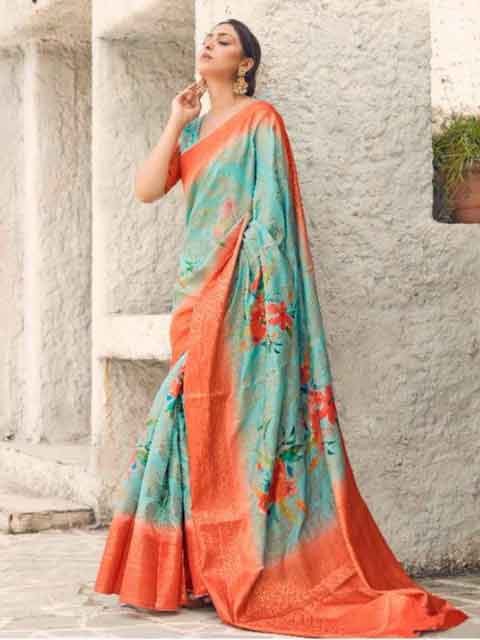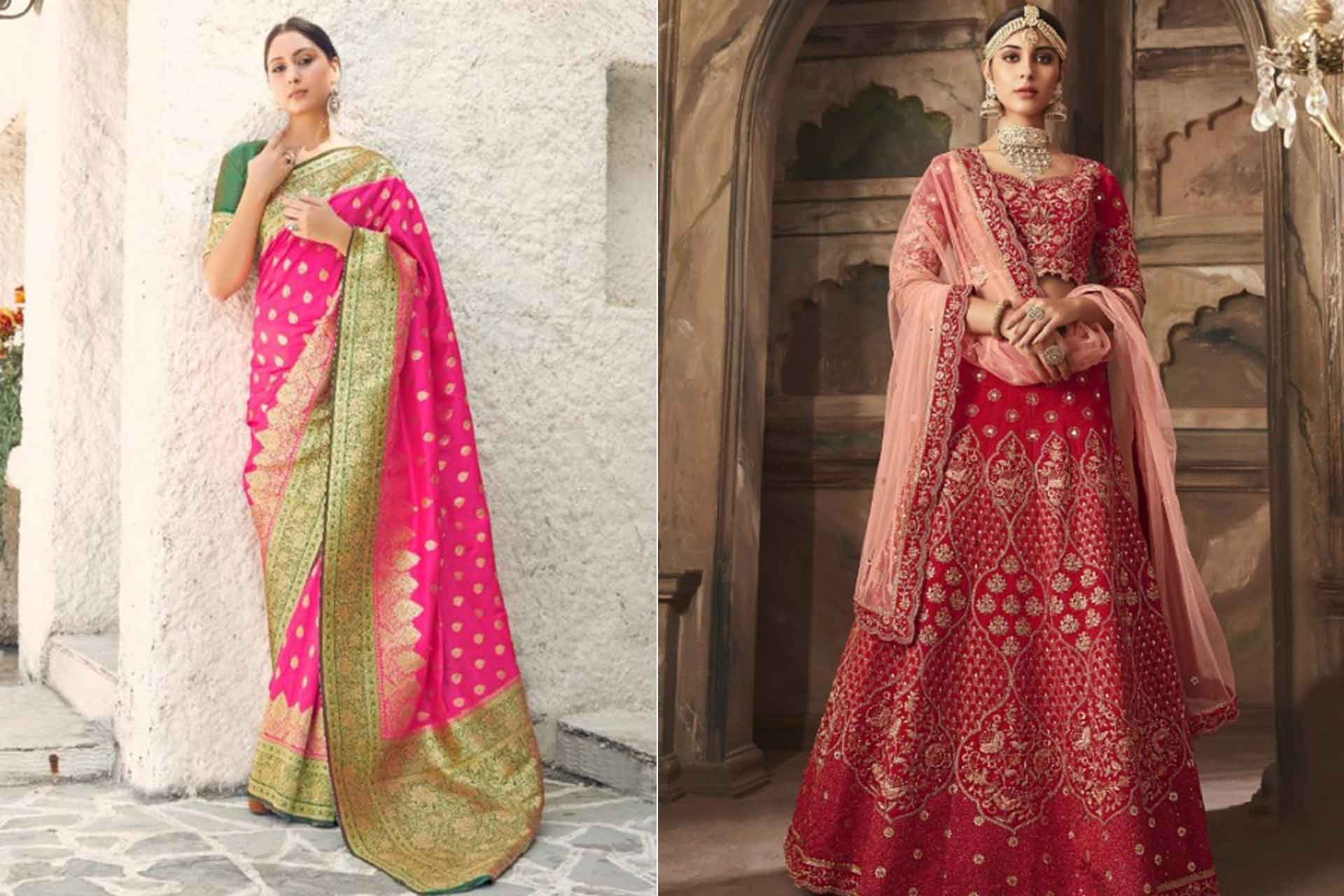Sarees and Lehengas are usually two of the most prominent dresses in an Indian woman’s wardrobe. So, it’s not surprising that most people new to ethnic Indian dresses and fashion often have questions about the differences between the two dresses.
One of the most recurring questions we get asked is what is the difference between a saree and a lehenga? Perhaps you’ve been trying to know this too. This guide will highlight the key differences between both of these iconic Indian dresses.

What Is a Saree?
We’ve discussed the saree in many of our posts.
The latest discussion can be found in our post titled Why Is Saree So Popular and Irresistible in India. You can find that post here! In there, we defined the Indian saree as;
A long piece of fabric that is usually unstitched and ranging from 3.5 to 9 yards that is beautifully draped around the body in layers.
The saree or sari is part of a three-piece outfit that’s also often referred to as a saree.
These include a petticoat and blouse. Indian women love sarees for the comfort, ease, and effortlessly chic appearance. It’s become a symbol of Indian fashion culture and is very commonly worn by women in South Asia and across the world.

What Is an Indian Lehenga?
The lehenga is also an equally popular piece of clothing in India. Here’s a simple definition of what a lehenga is;
A traditional Indian skirt with a length that runs from the waist down to the ankles; the lehenga is often pleated and embroidered and is a big choice among Indian women for weddings, formal occasions, and other big events.
Like the saree, the Indian Lehenga is also part of a three-piece outfit.
The three-piece outfit is often referred to as the lehenga choli or ghagra choli. The lehenga choli outfit comprises of the lehenga, a blouse, known as the choli, and a dupatta drape usually about 2.5 yards to match.
Differences Between a Saree and a Lehenga
There are a few similarities and several differences between a saree and a lehenga. The key differences, however, are laid bare in the table below;
| Differences | Saree | Lehenga |
| Design | A long unstitched piece of fabric designed to be draped around the body in layers. | A long skirt that runs from the waist to the ankles designed to be worn as the lower lehenga part of the lehenga choli attire. |
| Style/wearing options | A saree should be draped around the waist over a petticoat. | The lehenga should be worn as a skirt, below a choli top. |
| Prominence | Bridal lehengas are usually a top choice among Indian women. | Sarees are also popular for weddings as much as they are for everyday use. |
| Popularity | Saree is more popularly worn across India than the lehenga | Lehenga is popular in northern states but less popular across the country, compared to the saree. |
Both of these dresses are highly rated in India.
They are special dresses worn on special occasions. The costs may vary on certain factors that range from the type of fabric used, the type of design, as well as the choice of embroidery and embellishments used. If you’re keen on the different styles and design options available with both sarees and lehenga dresses.
Which Is Better: Saree or Lehenga?
The saree and lehenga are both beautiful dresses. This is why choosing either one of both dresses can be a tug of war.
Most times, brides-to-be have to choose between wearing a saree or a lehenga on their big day. Quite frankly, anyone will work, and you’ll look as gorgeous as the princess you should be. But what if you have to choose? The truth is that it really doesn’t matter whether you’re choosing a saree or a lehenga for your wedding or a casual outing. What matters most is how you wear what you wear.
Your choice of fabric as well as the design and embroidery work on the dress can impact your outlook. On casual occasions, you know you’ll be best served by simple or plain lehengas or monochrome sarees. This is so you don’t stand out from everyone sense in an awkward way. The same rules apply to your choice of jewelry and other accessories.
Lehengas or sarees for wedding
But if you’re a bride preparing for your wedding or styling yourself for a wedding or engagement party, then you might want to go for even more elaborate sarees and lehengas. The heavy embroidery and bling-y work, in this case, are perfect for the occasion.
At the end of the day, it’s not so much about what you wear rather than whether this conforms to your style tastes and personality preferences as well as whether you’re comfortable and confident enough in your dress.
Can a Saree Be Made Into a Lehenga?
Yes, you could make a saree into a lehenga.
More people nowadays are now making lehengas from silk sarees with a little bit of creativity to remold the outfit. If you have many old sarees that you can’t afford to throw away, you may consider giving them a new touch with a lehenga makeover.
But that aside, fashion designers are also doing a great job these days making lehenga-style sarees that incorporates the design elements of both a traditional saree and a conventional lehenga dress style. These styles combine design details from both the saree and lehenga to give your lehenga the same look and appearance as a saree.
Conclusion
Lehengas and sarees are two of India’s best dresses.
While the saree is worn on weddings as well as on other big occasions and everyday events, the lehenga is often more prominent on weddings and big events. If you’ve ever been confused about the two, we hope this guide has been able to help clear the misunderstandings.
And if you’re contemplating incorporating one or both of these dresses into your wardrobe, you might consider checking out some of the gorgeous styles and designs available on our store.

